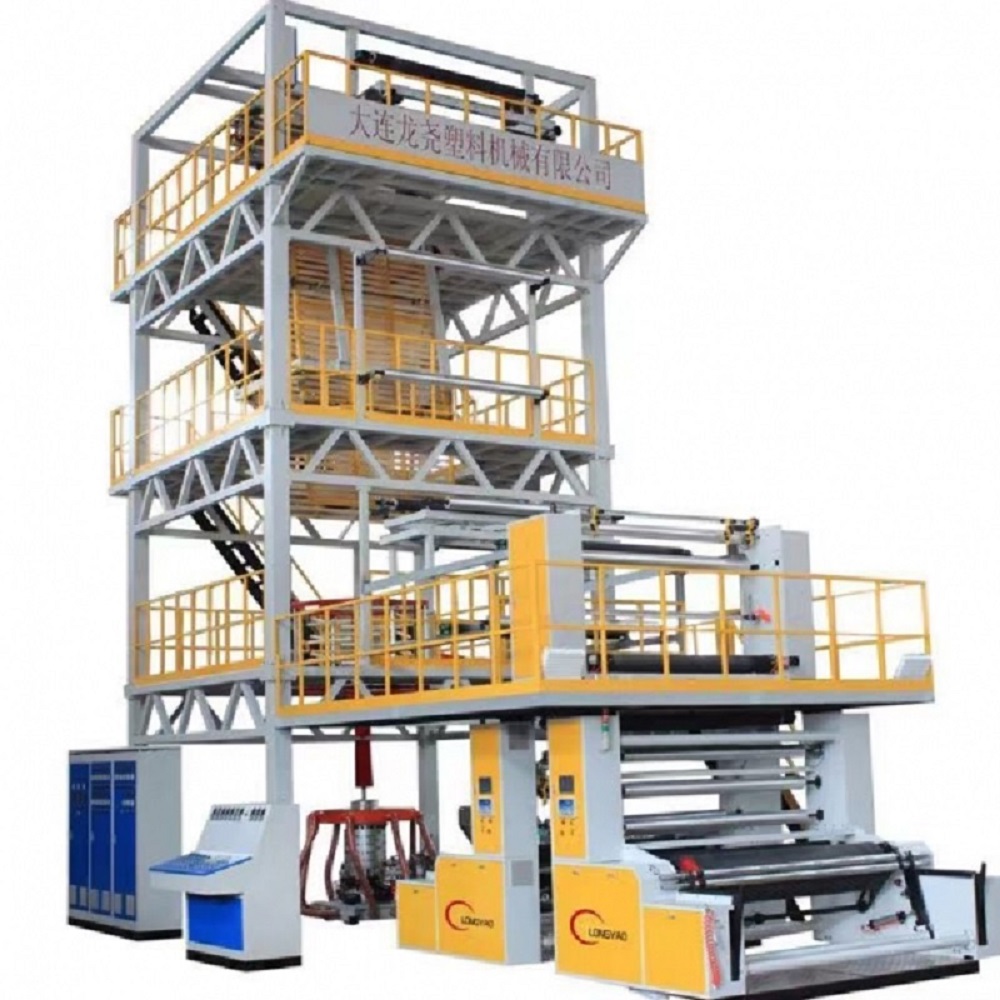Dalian Longyao Plastic Machinery Co., Ltd.
Contacts:Manager Xu
Mob:13354065688
Tel:0411-86268088
0411-86268988
BM:0411-86265066
Web:www.dllongyao.com
Email :xu86268088@126.com
Add:Lushun lime kiln, Dalian, Liaoning Province
Dalian Longyao Plastic Machinery Co., Ltd.
Contacts:Manager Xu
Mob:13354065688
Tel:0411-86268088
0411-86268988
BM:0411-86265066
Web:www.dllongyao.com
Email :xu86268088@126.com
Add:Lushun lime kiln, Dalian, Liaoning Province
The following is a detailed introduction to common faults and solutions of PE blown film machine:
1、 Uneven film thickness
Possible reasons:
Uneven temperature of the mold head: The heating coils in various areas of the mold head are damaged or the temperature controller fails, resulting in local temperatures being too high or too low.
Unstable melt pressure: fluctuation in extruder screw speed, impurities in the barrel, or poor plasticization of raw materials.
Improper inflation ratio: The inflation ratio is too large or too small, exceeding the equipment's process range, resulting in uneven lateral thickness of the film.
Inconsistent cooling effect: uneven distribution of air flow in the air ring, or significant differences in film cooling speed.
resolvent:
Check the heating coil and temperature controller of the mold head, repair or replace damaged parts, and ensure that the temperature error at each point is within ± 2 ℃.
Stabilize the screw speed, clean the impurities in the material barrel and screw, adjust the raw material formula or increase the plasticizing time.
Adjust the inflation ratio reasonably (usually 1.5-3.0 times) based on the characteristics of the raw materials and equipment parameters.
Calibrate the position of the air ring to ensure uniform air flow, and replace the air ring or adjust the power of the cooling fan if necessary.
2、 The film has wrinkles and folds
Possible reasons:
Uneven traction roller pressure: The gap between the upper and lower traction rollers is not consistent, or the pressure adjustment is improper.
Insufficient film cooling: The cooling rate is too slow, and the film softens at high temperatures during traction, resulting in wrinkles.
Unstable winding tension: The winding speed does not match the traction speed, or the tension control system is malfunctioning.
Uneven discharge from the mold head: blockage or wear of the mold head flow channel leads to inconsistent discharge of molten material from the left and right sides.
resolvent:
Adjust the traction roller pressure to ensure that the upper and lower rollers are parallel and the pressure is uniform. The gap can be measured with a feeler gauge (usually 0.5-1mm).
Increase the cooling air volume or reduce the traction speed to ensure that the film is fully cooled and shaped before entering the traction roller.
Calibrate the winding tension control system to synchronize the winding speed with the traction speed, which can be monitored in real time through tension sensors.
Disassemble the mold head to clean the flow channel, inspect and repair the worn parts, and replace the mold head components if necessary.
3、 The surface of the film is rough or has crystal dots
Possible reasons:
Poor plasticization of raw materials: The temperature of the material barrel is too low, the screw speed is too fast, or the moisture content of the raw materials is too high.
The flow channel of the mold head is not smooth: there are dead corners or residual material carbonization on the inner wall of the mold head, which hinders the flow of the melt.
Impurities mixed in: The raw materials contain impurities, the proportion of recycled materials is too high, or the hopper is not cleaned thoroughly.
Excessive cooling speed: For raw materials that require slow cooling (such as high-pressure PE), rapid cooling can cause uneven crystallization.
resolvent:
Raise the temperature of the material barrel and mold head (5-10 ℃ each time), reduce the screw speed, or dry the raw materials (moisture content<0.1%).
Regularly clean the die flow channel, use specialized tools to remove carbonized materials, and perform polishing treatment if necessary.
Replace pure raw materials, control the proportion of recycled materials (usually not exceeding 30%), and clean the hopper and feeding pipeline.
Reduce the cooling air volume or increase the ambient temperature to slowly cool the film and improve the crystalline structure.
4、 Insufficient longitudinal tensile strength of the film
Possible reasons:
Too low traction ratio: The ratio of traction speed to extrusion speed is too low, resulting in insufficient molecular chain orientation.
Improper selection of raw materials: using a high proportion of low-density PE (LDPE) or not adding an appropriate amount of linear low-density PE (LLDPE).
Excessive cooling temperature: Insufficient cooling leads to low crystallinity of the film and weak intermolecular forces.
resolvent:
Improve traction speed and increase traction ratio (usually 10-20 times), but avoid exceeding equipment limits that may cause film rupture.
Adjust the raw material formula, increase the proportion of LLDPE (such as from 20% to 30% -40%), or add reinforcing agents (such as metallocene catalysts).
Reduce the temperature of the cooling air ring or increase the air volume to ensure rapid cooling of the film and improve its crystallinity.
5、 Frequent film breakage
Possible reasons:
Excessive traction speed: exceeding the maximum tensile force that the film can withstand, resulting in longitudinal fracture.
Fluctuations in discharge pressure of the mold head: screw slippage, hard blocks in the raw material, or poor feeding of the material cylinder.
Excessive deviation in film thickness: Insufficient strength in locally thin areas, which can easily lead to fracture during traction.
Excessive winding tension: The pulling force of the winding roller on the film exceeds its strength limit.
resolvent:
Reduce traction speed and match extrusion volume by observing the stretching state of the film (if whitening occurs, reduce speed).
Check the wear of the screw and barrel, clean up foreign objects at the feed inlet, and ensure that the raw materials are evenly and stably fed.
Adjust the die gap or recalibrate the film thickness to eliminate local thinning points.
Reduce the winding tension or activate the automatic tension control system to adjust in real-time according to the film thickness.
6、 Abnormal noise or excessive vibration during equipment operation
Possible reasons:
Wear of screw and barrel: After long-term use, the gap increases, leading to fluctuations in melt pressure and mechanical friction.
Bearing damage: Insufficient lubrication or severe wear of traction rollers, winding rollers, or screw bearings.
Loose mechanical components: Loose bolts, couplings, or drive belts can cause shaking during operation.
Motor or reducer failure: lack of oil in motor bearings, wear of reducer gears, or unbalanced transmission.
resolvent:
Measure the gap between the screw and the barrel (normally 0.1-0.3mm), and replace the screw or barrel if it is severely worn.
Regularly add lubricating oil (such as lithium grease), check the bearing clearance, and replace it promptly if it is damaged.
Stop the machine to check the connecting bolts of each component, use a torque wrench to tighten according to the standard, and adjust the tension of the transmission belt.
Check the operating temperature of the motor and reducer, replace worn gears or bearings, and calibrate the coaxiality of the transmission system.
Maintenance suggestions
Regular cleaning: Clean the mold head, screw, and barrel weekly to prevent material carbonization; Check the accuracy of heating coils, temperature controllers, and sensors every month.
Raw material management: Strictly control the moisture content and impurities of raw materials, store different grades of raw materials separately, and avoid mixing.
Process records: Establish equipment operation logs to record parameters such as temperature, pressure, and traction ratio for easy fault tracing and process optimization.
Personnel training: Operators need to be familiar with equipment performance and material characteristics, and master emergency shutdown and simple troubleshooting skills.
The above methods can effectively solve common faults of PE blown film machines, improve film quality and production efficiency. If encountering complex problems (such as severe wear of screws or control system failures), it is recommended to contact professional maintenance personnel for handling.

Contacts:Manager Xu
Mob:13354065688
Tel:0411-86268088/0411-86268988
BM:0411-86265066
Web:www.dllongyao.com
Email :xu86268088@126.com
Add:Lushun lime kiln, Dalian, Liaoning Province

Mobile station
Copyright ©Http://Www.Dllongyao.Com/En/ Dalian Longyao Plastic Machinery Co., Ltd Specializing inPE Film Blowing Machine,Three Layer Coextrusion Film Blowing Machine,ABA Film Blowing Machine, Welcome to inquire!
辽ICP备14017684号 Powered By Xiangyun platform Technical support: joint enterprise Era
